Comprehensive Report on Big Data: Analytics, Challenges & Support
VerifiedAdded on 2023/06/14
|9
|2360
|122
Report
AI Summary
This report provides a comprehensive overview of big data, starting with its history and evolution, highlighting key characteristics such as volume, variety, veracity, velocity, and value. It delves into the challenges associated with big data analytics, including understanding the data, handling diverse data types, selecting appropriate tools, ensuring data security, and managing data accumulation. The report also explores various techniques for analyzing big data, such as machine learning, statistical classification analysis, regression analysis, social network analysis, and association rule learning. Furthermore, it discusses the support that big data technology offers to businesses, including competitive pricing, improved efficiency, cost advantages, and increased sales through customer loyalty. The report concludes that businesses can leverage big data analytics for innovation and competitive advantage by addressing the challenges and utilizing appropriate tools and techniques. Desklib provides access to similar solved assignments and past papers for students.

4005 1
Paraphrase This Document
Need a fresh take? Get an instant paraphrase of this document with our AI Paraphraser
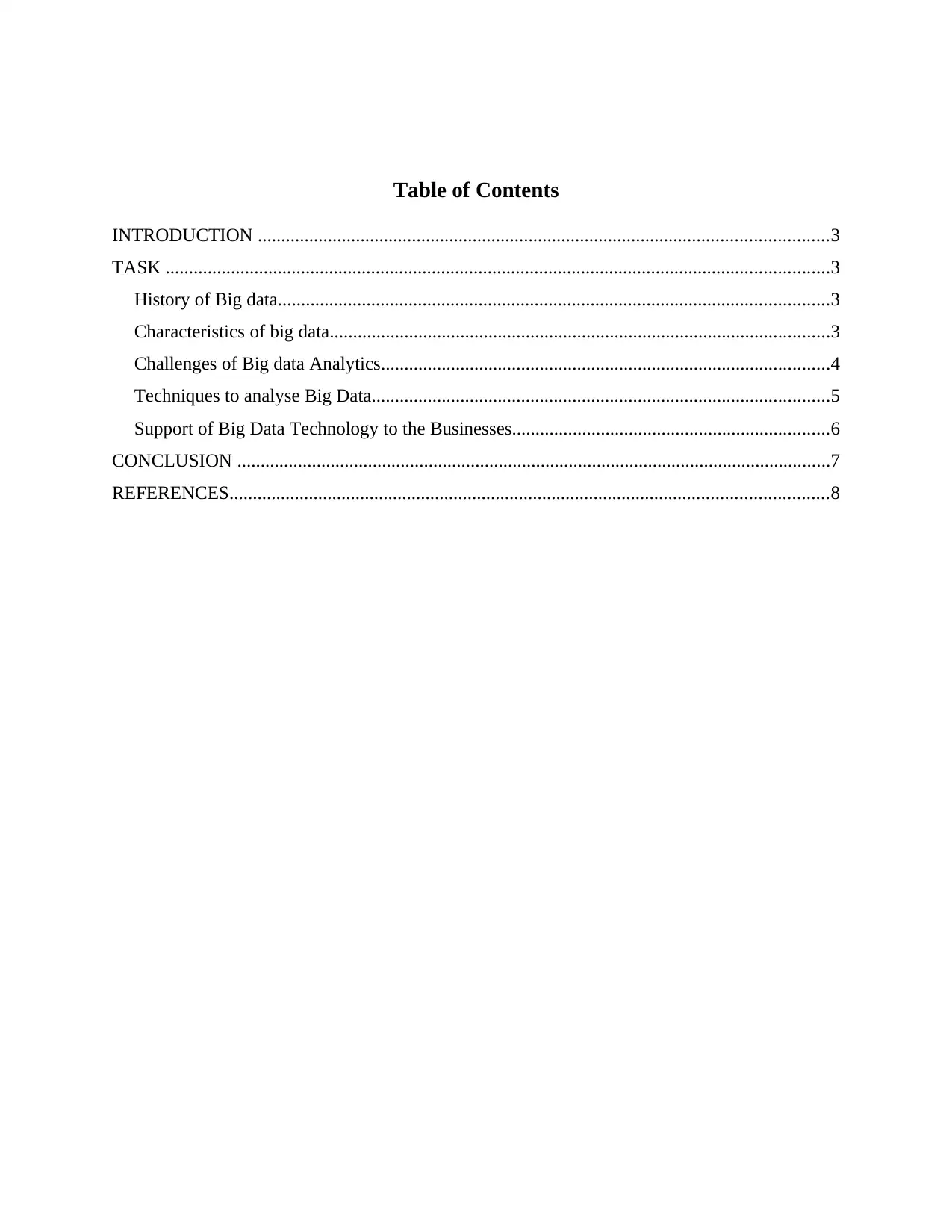
Table of Contents
INTRODUCTION ..........................................................................................................................3
TASK ..............................................................................................................................................3
History of Big data......................................................................................................................3
Characteristics of big data...........................................................................................................3
Challenges of Big data Analytics................................................................................................4
Techniques to analyse Big Data..................................................................................................5
Support of Big Data Technology to the Businesses....................................................................6
CONCLUSION ...............................................................................................................................7
REFERENCES................................................................................................................................8
INTRODUCTION ..........................................................................................................................3
TASK ..............................................................................................................................................3
History of Big data......................................................................................................................3
Characteristics of big data...........................................................................................................3
Challenges of Big data Analytics................................................................................................4
Techniques to analyse Big Data..................................................................................................5
Support of Big Data Technology to the Businesses....................................................................6
CONCLUSION ...............................................................................................................................7
REFERENCES................................................................................................................................8
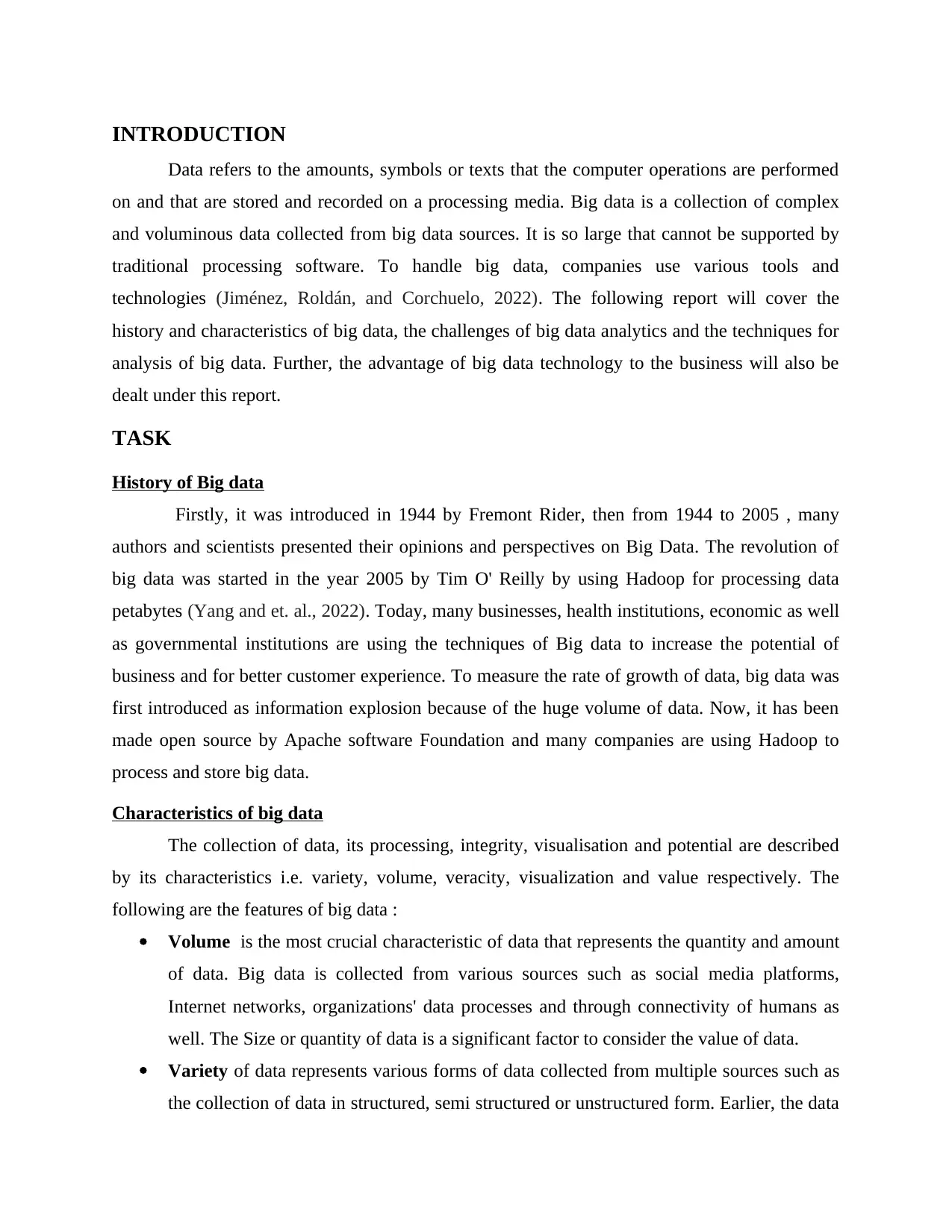
INTRODUCTION
Data refers to the amounts, symbols or texts that the computer operations are performed
on and that are stored and recorded on a processing media. Big data is a collection of complex
and voluminous data collected from big data sources. It is so large that cannot be supported by
traditional processing software. To handle big data, companies use various tools and
technologies (Jiménez, Roldán, and Corchuelo, 2022). The following report will cover the
history and characteristics of big data, the challenges of big data analytics and the techniques for
analysis of big data. Further, the advantage of big data technology to the business will also be
dealt under this report.
TASK
History of Big data
Firstly, it was introduced in 1944 by Fremont Rider, then from 1944 to 2005 , many
authors and scientists presented their opinions and perspectives on Big Data. The revolution of
big data was started in the year 2005 by Tim O' Reilly by using Hadoop for processing data
petabytes (Yang and et. al., 2022). Today, many businesses, health institutions, economic as well
as governmental institutions are using the techniques of Big data to increase the potential of
business and for better customer experience. To measure the rate of growth of data, big data was
first introduced as information explosion because of the huge volume of data. Now, it has been
made open source by Apache software Foundation and many companies are using Hadoop to
process and store big data.
Characteristics of big data
The collection of data, its processing, integrity, visualisation and potential are described
by its characteristics i.e. variety, volume, veracity, visualization and value respectively. The
following are the features of big data :
Volume is the most crucial characteristic of data that represents the quantity and amount
of data. Big data is collected from various sources such as social media platforms,
Internet networks, organizations' data processes and through connectivity of humans as
well. The Size or quantity of data is a significant factor to consider the value of data.
Variety of data represents various forms of data collected from multiple sources such as
the collection of data in structured, semi structured or unstructured form. Earlier, the data
Data refers to the amounts, symbols or texts that the computer operations are performed
on and that are stored and recorded on a processing media. Big data is a collection of complex
and voluminous data collected from big data sources. It is so large that cannot be supported by
traditional processing software. To handle big data, companies use various tools and
technologies (Jiménez, Roldán, and Corchuelo, 2022). The following report will cover the
history and characteristics of big data, the challenges of big data analytics and the techniques for
analysis of big data. Further, the advantage of big data technology to the business will also be
dealt under this report.
TASK
History of Big data
Firstly, it was introduced in 1944 by Fremont Rider, then from 1944 to 2005 , many
authors and scientists presented their opinions and perspectives on Big Data. The revolution of
big data was started in the year 2005 by Tim O' Reilly by using Hadoop for processing data
petabytes (Yang and et. al., 2022). Today, many businesses, health institutions, economic as well
as governmental institutions are using the techniques of Big data to increase the potential of
business and for better customer experience. To measure the rate of growth of data, big data was
first introduced as information explosion because of the huge volume of data. Now, it has been
made open source by Apache software Foundation and many companies are using Hadoop to
process and store big data.
Characteristics of big data
The collection of data, its processing, integrity, visualisation and potential are described
by its characteristics i.e. variety, volume, veracity, visualization and value respectively. The
following are the features of big data :
Volume is the most crucial characteristic of data that represents the quantity and amount
of data. Big data is collected from various sources such as social media platforms,
Internet networks, organizations' data processes and through connectivity of humans as
well. The Size or quantity of data is a significant factor to consider the value of data.
Variety of data represents various forms of data collected from multiple sources such as
the collection of data in structured, semi structured or unstructured form. Earlier, the data
⊘ This is a preview!⊘
Do you want full access?
Subscribe today to unlock all pages.

Trusted by 1+ million students worldwide
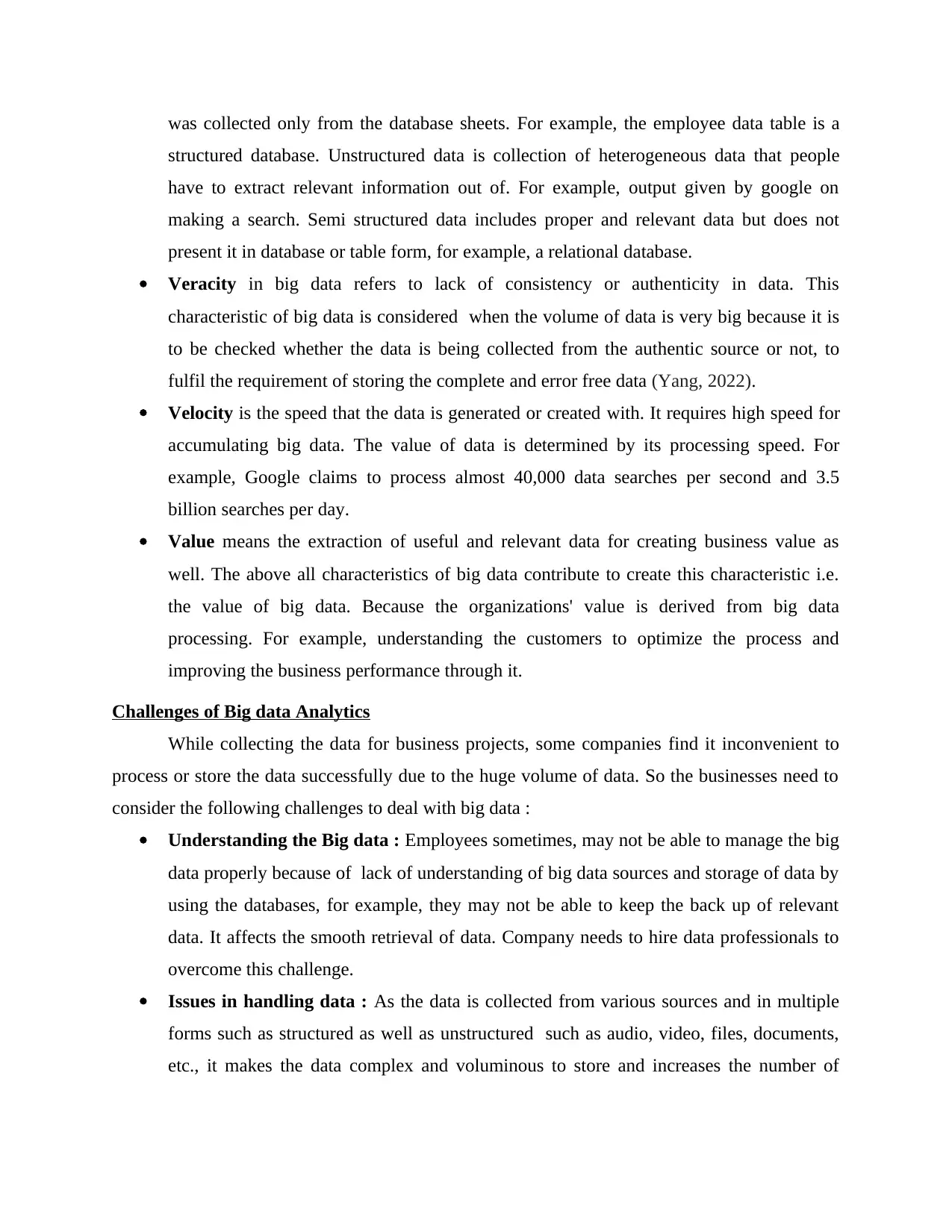
was collected only from the database sheets. For example, the employee data table is a
structured database. Unstructured data is collection of heterogeneous data that people
have to extract relevant information out of. For example, output given by google on
making a search. Semi structured data includes proper and relevant data but does not
present it in database or table form, for example, a relational database.
Veracity in big data refers to lack of consistency or authenticity in data. This
characteristic of big data is considered when the volume of data is very big because it is
to be checked whether the data is being collected from the authentic source or not, to
fulfil the requirement of storing the complete and error free data (Yang, 2022).
Velocity is the speed that the data is generated or created with. It requires high speed for
accumulating big data. The value of data is determined by its processing speed. For
example, Google claims to process almost 40,000 data searches per second and 3.5
billion searches per day.
Value means the extraction of useful and relevant data for creating business value as
well. The above all characteristics of big data contribute to create this characteristic i.e.
the value of big data. Because the organizations' value is derived from big data
processing. For example, understanding the customers to optimize the process and
improving the business performance through it.
Challenges of Big data Analytics
While collecting the data for business projects, some companies find it inconvenient to
process or store the data successfully due to the huge volume of data. So the businesses need to
consider the following challenges to deal with big data :
Understanding the Big data : Employees sometimes, may not be able to manage the big
data properly because of lack of understanding of big data sources and storage of data by
using the databases, for example, they may not be able to keep the back up of relevant
data. It affects the smooth retrieval of data. Company needs to hire data professionals to
overcome this challenge.
Issues in handling data : As the data is collected from various sources and in multiple
forms such as structured as well as unstructured such as audio, video, files, documents,
etc., it makes the data complex and voluminous to store and increases the number of
structured database. Unstructured data is collection of heterogeneous data that people
have to extract relevant information out of. For example, output given by google on
making a search. Semi structured data includes proper and relevant data but does not
present it in database or table form, for example, a relational database.
Veracity in big data refers to lack of consistency or authenticity in data. This
characteristic of big data is considered when the volume of data is very big because it is
to be checked whether the data is being collected from the authentic source or not, to
fulfil the requirement of storing the complete and error free data (Yang, 2022).
Velocity is the speed that the data is generated or created with. It requires high speed for
accumulating big data. The value of data is determined by its processing speed. For
example, Google claims to process almost 40,000 data searches per second and 3.5
billion searches per day.
Value means the extraction of useful and relevant data for creating business value as
well. The above all characteristics of big data contribute to create this characteristic i.e.
the value of big data. Because the organizations' value is derived from big data
processing. For example, understanding the customers to optimize the process and
improving the business performance through it.
Challenges of Big data Analytics
While collecting the data for business projects, some companies find it inconvenient to
process or store the data successfully due to the huge volume of data. So the businesses need to
consider the following challenges to deal with big data :
Understanding the Big data : Employees sometimes, may not be able to manage the big
data properly because of lack of understanding of big data sources and storage of data by
using the databases, for example, they may not be able to keep the back up of relevant
data. It affects the smooth retrieval of data. Company needs to hire data professionals to
overcome this challenge.
Issues in handling data : As the data is collected from various sources and in multiple
forms such as structured as well as unstructured such as audio, video, files, documents,
etc., it makes the data complex and voluminous to store and increases the number of
Paraphrase This Document
Need a fresh take? Get an instant paraphrase of this document with our AI Paraphraser
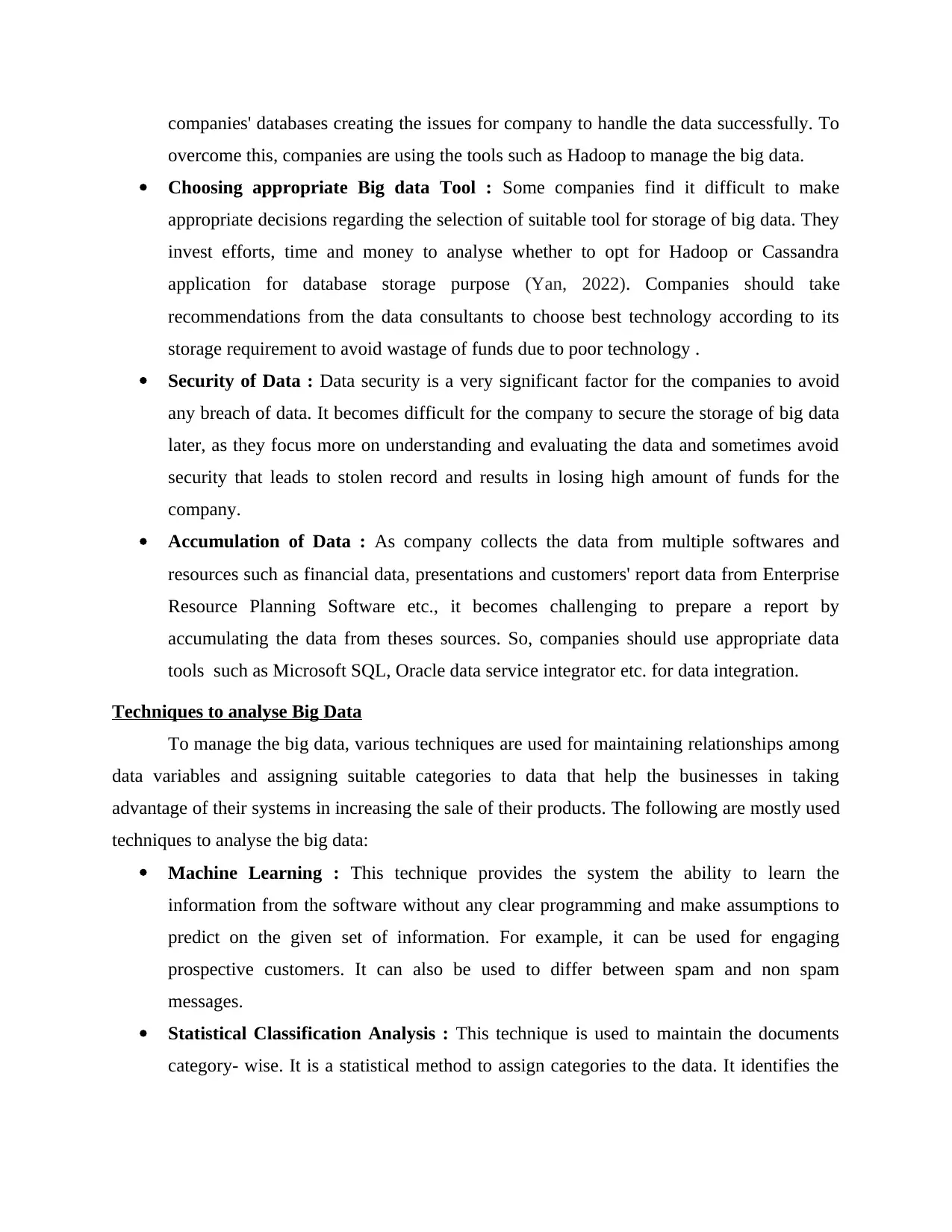
companies' databases creating the issues for company to handle the data successfully. To
overcome this, companies are using the tools such as Hadoop to manage the big data.
Choosing appropriate Big data Tool : Some companies find it difficult to make
appropriate decisions regarding the selection of suitable tool for storage of big data. They
invest efforts, time and money to analyse whether to opt for Hadoop or Cassandra
application for database storage purpose (Yan, 2022). Companies should take
recommendations from the data consultants to choose best technology according to its
storage requirement to avoid wastage of funds due to poor technology .
Security of Data : Data security is a very significant factor for the companies to avoid
any breach of data. It becomes difficult for the company to secure the storage of big data
later, as they focus more on understanding and evaluating the data and sometimes avoid
security that leads to stolen record and results in losing high amount of funds for the
company.
Accumulation of Data : As company collects the data from multiple softwares and
resources such as financial data, presentations and customers' report data from Enterprise
Resource Planning Software etc., it becomes challenging to prepare a report by
accumulating the data from theses sources. So, companies should use appropriate data
tools such as Microsoft SQL, Oracle data service integrator etc. for data integration.
Techniques to analyse Big Data
To manage the big data, various techniques are used for maintaining relationships among
data variables and assigning suitable categories to data that help the businesses in taking
advantage of their systems in increasing the sale of their products. The following are mostly used
techniques to analyse the big data:
Machine Learning : This technique provides the system the ability to learn the
information from the software without any clear programming and make assumptions to
predict on the given set of information. For example, it can be used for engaging
prospective customers. It can also be used to differ between spam and non spam
messages.
Statistical Classification Analysis : This technique is used to maintain the documents
category- wise. It is a statistical method to assign categories to the data. It identifies the
overcome this, companies are using the tools such as Hadoop to manage the big data.
Choosing appropriate Big data Tool : Some companies find it difficult to make
appropriate decisions regarding the selection of suitable tool for storage of big data. They
invest efforts, time and money to analyse whether to opt for Hadoop or Cassandra
application for database storage purpose (Yan, 2022). Companies should take
recommendations from the data consultants to choose best technology according to its
storage requirement to avoid wastage of funds due to poor technology .
Security of Data : Data security is a very significant factor for the companies to avoid
any breach of data. It becomes difficult for the company to secure the storage of big data
later, as they focus more on understanding and evaluating the data and sometimes avoid
security that leads to stolen record and results in losing high amount of funds for the
company.
Accumulation of Data : As company collects the data from multiple softwares and
resources such as financial data, presentations and customers' report data from Enterprise
Resource Planning Software etc., it becomes challenging to prepare a report by
accumulating the data from theses sources. So, companies should use appropriate data
tools such as Microsoft SQL, Oracle data service integrator etc. for data integration.
Techniques to analyse Big Data
To manage the big data, various techniques are used for maintaining relationships among
data variables and assigning suitable categories to data that help the businesses in taking
advantage of their systems in increasing the sale of their products. The following are mostly used
techniques to analyse the big data:
Machine Learning : This technique provides the system the ability to learn the
information from the software without any clear programming and make assumptions to
predict on the given set of information. For example, it can be used for engaging
prospective customers. It can also be used to differ between spam and non spam
messages.
Statistical Classification Analysis : This technique is used to maintain the documents
category- wise. It is a statistical method to assign categories to the data. It identifies the
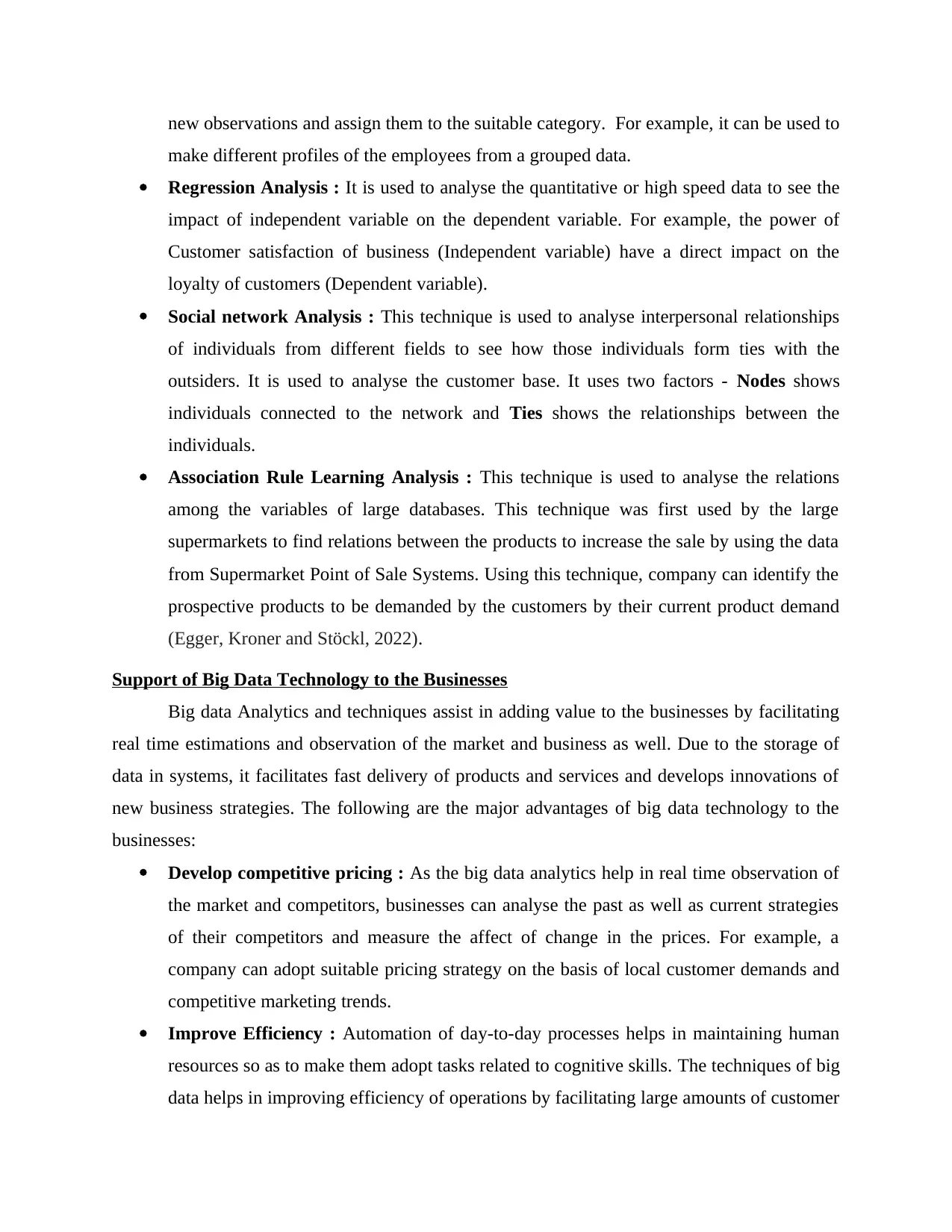
new observations and assign them to the suitable category. For example, it can be used to
make different profiles of the employees from a grouped data.
Regression Analysis : It is used to analyse the quantitative or high speed data to see the
impact of independent variable on the dependent variable. For example, the power of
Customer satisfaction of business (Independent variable) have a direct impact on the
loyalty of customers (Dependent variable).
Social network Analysis : This technique is used to analyse interpersonal relationships
of individuals from different fields to see how those individuals form ties with the
outsiders. It is used to analyse the customer base. It uses two factors - Nodes shows
individuals connected to the network and Ties shows the relationships between the
individuals.
Association Rule Learning Analysis : This technique is used to analyse the relations
among the variables of large databases. This technique was first used by the large
supermarkets to find relations between the products to increase the sale by using the data
from Supermarket Point of Sale Systems. Using this technique, company can identify the
prospective products to be demanded by the customers by their current product demand
(Egger, Kroner and Stöckl, 2022).
Support of Big Data Technology to the Businesses
Big data Analytics and techniques assist in adding value to the businesses by facilitating
real time estimations and observation of the market and business as well. Due to the storage of
data in systems, it facilitates fast delivery of products and services and develops innovations of
new business strategies. The following are the major advantages of big data technology to the
businesses:
Develop competitive pricing : As the big data analytics help in real time observation of
the market and competitors, businesses can analyse the past as well as current strategies
of their competitors and measure the affect of change in the prices. For example, a
company can adopt suitable pricing strategy on the basis of local customer demands and
competitive marketing trends.
Improve Efficiency : Automation of day-to-day processes helps in maintaining human
resources so as to make them adopt tasks related to cognitive skills. The techniques of big
data helps in improving efficiency of operations by facilitating large amounts of customer
make different profiles of the employees from a grouped data.
Regression Analysis : It is used to analyse the quantitative or high speed data to see the
impact of independent variable on the dependent variable. For example, the power of
Customer satisfaction of business (Independent variable) have a direct impact on the
loyalty of customers (Dependent variable).
Social network Analysis : This technique is used to analyse interpersonal relationships
of individuals from different fields to see how those individuals form ties with the
outsiders. It is used to analyse the customer base. It uses two factors - Nodes shows
individuals connected to the network and Ties shows the relationships between the
individuals.
Association Rule Learning Analysis : This technique is used to analyse the relations
among the variables of large databases. This technique was first used by the large
supermarkets to find relations between the products to increase the sale by using the data
from Supermarket Point of Sale Systems. Using this technique, company can identify the
prospective products to be demanded by the customers by their current product demand
(Egger, Kroner and Stöckl, 2022).
Support of Big Data Technology to the Businesses
Big data Analytics and techniques assist in adding value to the businesses by facilitating
real time estimations and observation of the market and business as well. Due to the storage of
data in systems, it facilitates fast delivery of products and services and develops innovations of
new business strategies. The following are the major advantages of big data technology to the
businesses:
Develop competitive pricing : As the big data analytics help in real time observation of
the market and competitors, businesses can analyse the past as well as current strategies
of their competitors and measure the affect of change in the prices. For example, a
company can adopt suitable pricing strategy on the basis of local customer demands and
competitive marketing trends.
Improve Efficiency : Automation of day-to-day processes helps in maintaining human
resources so as to make them adopt tasks related to cognitive skills. The techniques of big
data helps in improving efficiency of operations by facilitating large amounts of customer
⊘ This is a preview!⊘
Do you want full access?
Subscribe today to unlock all pages.

Trusted by 1+ million students worldwide
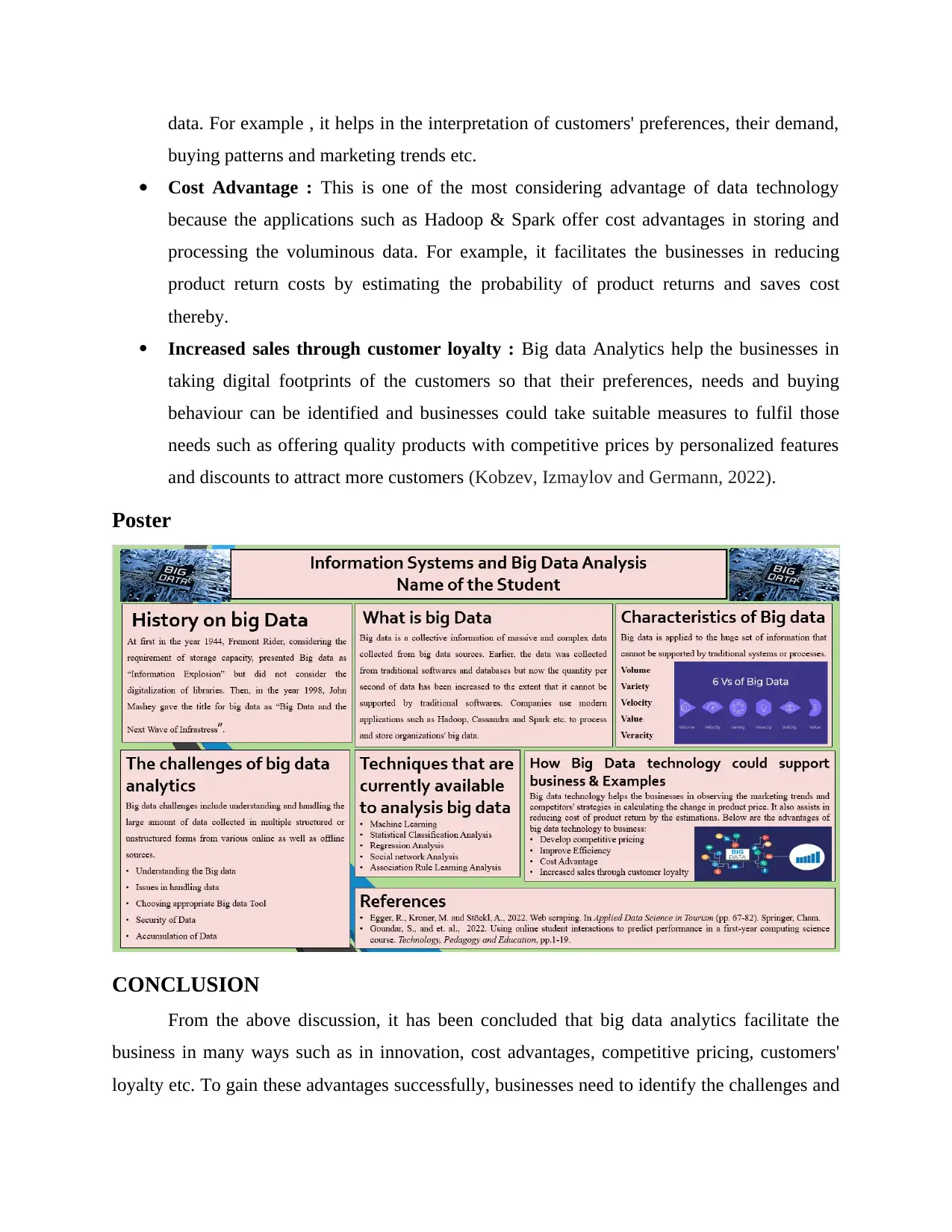
data. For example , it helps in the interpretation of customers' preferences, their demand,
buying patterns and marketing trends etc.
Cost Advantage : This is one of the most considering advantage of data technology
because the applications such as Hadoop & Spark offer cost advantages in storing and
processing the voluminous data. For example, it facilitates the businesses in reducing
product return costs by estimating the probability of product returns and saves cost
thereby.
Increased sales through customer loyalty : Big data Analytics help the businesses in
taking digital footprints of the customers so that their preferences, needs and buying
behaviour can be identified and businesses could take suitable measures to fulfil those
needs such as offering quality products with competitive prices by personalized features
and discounts to attract more customers (Kobzev, Izmaylov and Germann, 2022).
Poster
CONCLUSION
From the above discussion, it has been concluded that big data analytics facilitate the
business in many ways such as in innovation, cost advantages, competitive pricing, customers'
loyalty etc. To gain these advantages successfully, businesses need to identify the challenges and
buying patterns and marketing trends etc.
Cost Advantage : This is one of the most considering advantage of data technology
because the applications such as Hadoop & Spark offer cost advantages in storing and
processing the voluminous data. For example, it facilitates the businesses in reducing
product return costs by estimating the probability of product returns and saves cost
thereby.
Increased sales through customer loyalty : Big data Analytics help the businesses in
taking digital footprints of the customers so that their preferences, needs and buying
behaviour can be identified and businesses could take suitable measures to fulfil those
needs such as offering quality products with competitive prices by personalized features
and discounts to attract more customers (Kobzev, Izmaylov and Germann, 2022).
Poster
CONCLUSION
From the above discussion, it has been concluded that big data analytics facilitate the
business in many ways such as in innovation, cost advantages, competitive pricing, customers'
loyalty etc. To gain these advantages successfully, businesses need to identify the challenges and
Paraphrase This Document
Need a fresh take? Get an instant paraphrase of this document with our AI Paraphraser

overcome them by using suitable Big data tool such as Hadoop, Cassandra or Spark to support
the storage, processing and retrieval of data with managing its accumulation and ensuring
security as well. To handle the big data systematically, companies should use suitable techniques
of big data analysis such as machine learning or association rule learning technique.
the storage, processing and retrieval of data with managing its accumulation and ensuring
security as well. To handle the big data systematically, companies should use suitable techniques
of big data analysis such as machine learning or association rule learning technique.
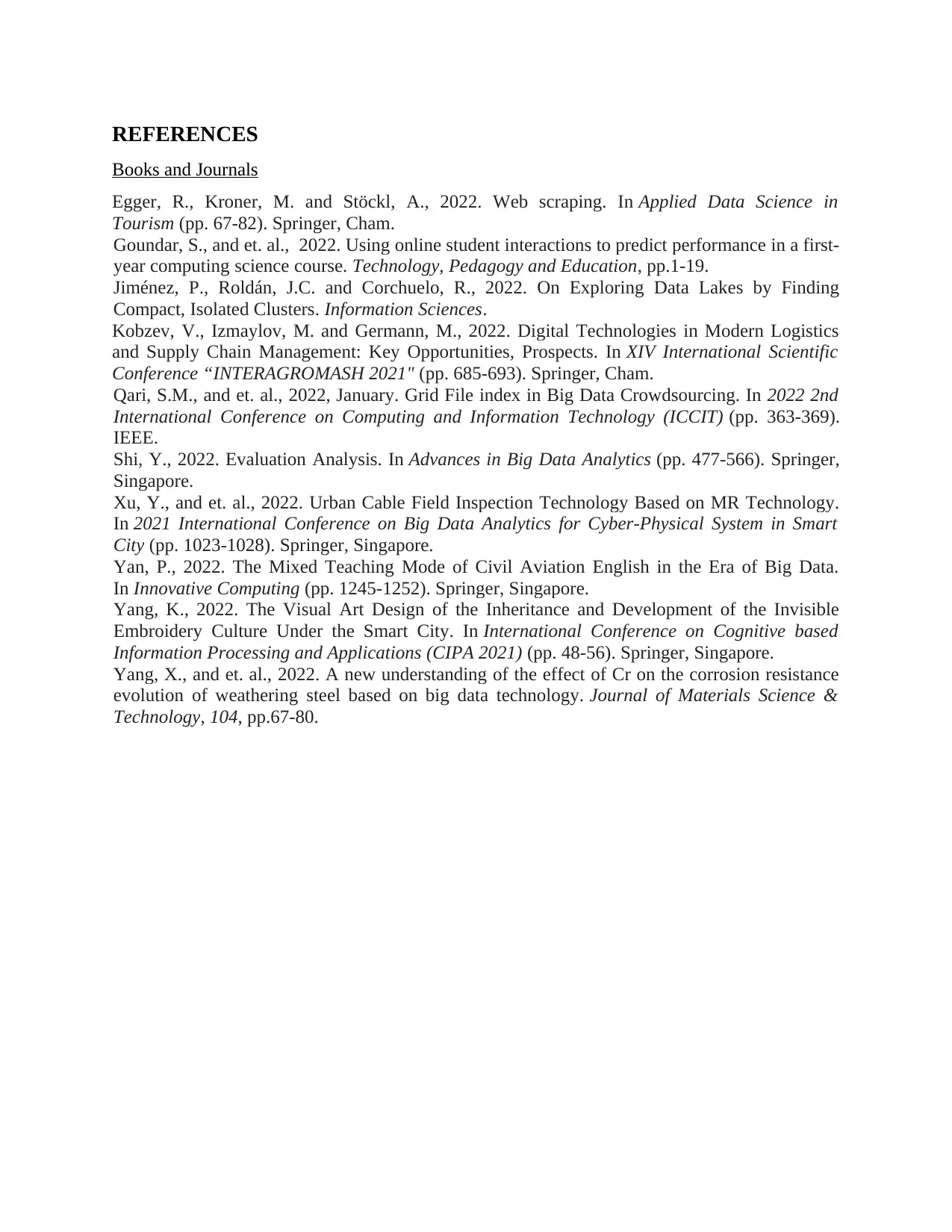
REFERENCES
Books and Journals
Egger, R., Kroner, M. and Stöckl, A., 2022. Web scraping. In Applied Data Science in
Tourism (pp. 67-82). Springer, Cham.
Goundar, S., and et. al., 2022. Using online student interactions to predict performance in a first-
year computing science course. Technology, Pedagogy and Education, pp.1-19.
Jiménez, P., Roldán, J.C. and Corchuelo, R., 2022. On Exploring Data Lakes by Finding
Compact, Isolated Clusters. Information Sciences.
Kobzev, V., Izmaylov, M. and Germann, M., 2022. Digital Technologies in Modern Logistics
and Supply Chain Management: Key Opportunities, Prospects. In XIV International Scientific
Conference “INTERAGROMASH 2021" (pp. 685-693). Springer, Cham.
Qari, S.M., and et. al., 2022, January. Grid File index in Big Data Crowdsourcing. In 2022 2nd
International Conference on Computing and Information Technology (ICCIT) (pp. 363-369).
IEEE.
Shi, Y., 2022. Evaluation Analysis. In Advances in Big Data Analytics (pp. 477-566). Springer,
Singapore.
Xu, Y., and et. al., 2022. Urban Cable Field Inspection Technology Based on MR Technology.
In 2021 International Conference on Big Data Analytics for Cyber-Physical System in Smart
City (pp. 1023-1028). Springer, Singapore.
Yan, P., 2022. The Mixed Teaching Mode of Civil Aviation English in the Era of Big Data.
In Innovative Computing (pp. 1245-1252). Springer, Singapore.
Yang, K., 2022. The Visual Art Design of the Inheritance and Development of the Invisible
Embroidery Culture Under the Smart City. In International Conference on Cognitive based
Information Processing and Applications (CIPA 2021) (pp. 48-56). Springer, Singapore.
Yang, X., and et. al., 2022. A new understanding of the effect of Cr on the corrosion resistance
evolution of weathering steel based on big data technology. Journal of Materials Science &
Technology, 104, pp.67-80.
Books and Journals
Egger, R., Kroner, M. and Stöckl, A., 2022. Web scraping. In Applied Data Science in
Tourism (pp. 67-82). Springer, Cham.
Goundar, S., and et. al., 2022. Using online student interactions to predict performance in a first-
year computing science course. Technology, Pedagogy and Education, pp.1-19.
Jiménez, P., Roldán, J.C. and Corchuelo, R., 2022. On Exploring Data Lakes by Finding
Compact, Isolated Clusters. Information Sciences.
Kobzev, V., Izmaylov, M. and Germann, M., 2022. Digital Technologies in Modern Logistics
and Supply Chain Management: Key Opportunities, Prospects. In XIV International Scientific
Conference “INTERAGROMASH 2021" (pp. 685-693). Springer, Cham.
Qari, S.M., and et. al., 2022, January. Grid File index in Big Data Crowdsourcing. In 2022 2nd
International Conference on Computing and Information Technology (ICCIT) (pp. 363-369).
IEEE.
Shi, Y., 2022. Evaluation Analysis. In Advances in Big Data Analytics (pp. 477-566). Springer,
Singapore.
Xu, Y., and et. al., 2022. Urban Cable Field Inspection Technology Based on MR Technology.
In 2021 International Conference on Big Data Analytics for Cyber-Physical System in Smart
City (pp. 1023-1028). Springer, Singapore.
Yan, P., 2022. The Mixed Teaching Mode of Civil Aviation English in the Era of Big Data.
In Innovative Computing (pp. 1245-1252). Springer, Singapore.
Yang, K., 2022. The Visual Art Design of the Inheritance and Development of the Invisible
Embroidery Culture Under the Smart City. In International Conference on Cognitive based
Information Processing and Applications (CIPA 2021) (pp. 48-56). Springer, Singapore.
Yang, X., and et. al., 2022. A new understanding of the effect of Cr on the corrosion resistance
evolution of weathering steel based on big data technology. Journal of Materials Science &
Technology, 104, pp.67-80.
⊘ This is a preview!⊘
Do you want full access?
Subscribe today to unlock all pages.

Trusted by 1+ million students worldwide
1 out of 9
Related Documents
Your All-in-One AI-Powered Toolkit for Academic Success.
+13062052269
info@desklib.com
Available 24*7 on WhatsApp / Email
![[object Object]](/_next/static/media/star-bottom.7253800d.svg)
Unlock your academic potential
Copyright © 2020–2025 A2Z Services. All Rights Reserved. Developed and managed by ZUCOL.

